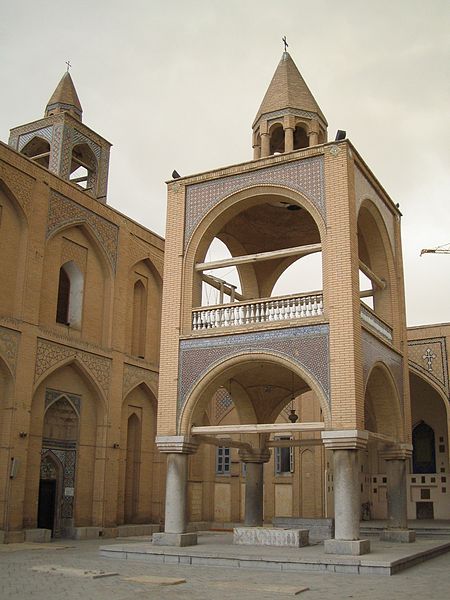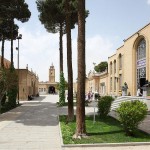New Julfa ( literally “Jolfa quarter of Esfahan”; Armenian: Նոր Ջուղա, Nor Jugha) is the Armenian quarter of Isfahan, Iran, located along the south bank of the river Zayandeh River.
New Julfa was established in 1606 as an Armenian quarter by edict of Shah Abbas I, the influential shah from the Safavid dynasty. Over 150,000 Armenians were moved there from Julfa (also known as Jugha or Juła) in Nakhichevan. Iranian accounts state that the Armenians came to Persia fleeing the Ottoman Empire’s persecution;. An evidence for that is kingdom letters from Shah Abbas I to transfer ownership of some of the best lands in north side of zayandeh rood river to Armenian which is honored during all next kings and governments. All history accounts agree that, as the residents of Julfa were famous for their silk trade (Kévonian, Baghdiantz, Herzig), Shah Abbas treated the population well and hoped that their settlement in Isfahan would be beneficial to Persia.
In 1947 the famous historian Fernand Braudel wrote that the Armenians had a network that stretched from Amsterdam to Manila in the Philippines. Many scholars in Armenia have done pioneering work on this network in the 60’s, 70’s and 80’s, Levon Khachikian and Sushanik Khachikian have edited and published several New Julfan account books. Over the next few centuries, New Julfa became the hub of “one of the greatest trade networks of the early modern era” (Aslanian 2008: 128), with outposts as far east as Canton, Surabaya, and Manila (Bhattacharya) and as far west as Cadiz, London, and Amsterdam, with a few merchants traveling across the Atlantic or Pacific oceans to Acapulco or Mexico City.
New Julfa’s also controlled many of the Armenian trading families and their churches in India, families that were originally from Julfa (Baghdiantz, Chaudhuri, see also Mesrop Seth) Hughli was a main settlement in Bengal (Chaudhuri). Some scholars argue that Surat, Bengal and Hughli were independent nodes and that the central control of New Julfa was not as important to their thriving Indian Ocean trade (Bhattacharya). Many New Julfan Armenians later settled in Manila, Hong Kong and also in Australia. Their networks and have been studied based on Armenian sources (Baghdiantz, Kévonian, Khachikian). Not forgetting Singapore where Armenians from New Julfa became the mainstay of the community. Most were traders, but perhaps better known were the Sarkies (Ter Woskanian) brothers who founded Singapore’s iconic Raffles Hotel in 1887. [Wright]
New Julfa is still an Armenian-populated area with an Armenian school and sixteen churches, including Surp Amenaprgitch Vank. Armenians in New Julfa observe Iranian law with regard to clothing, but otherwise retain a distinct Armenian language, identity and culture (Ghougassian). The policy of the Safavids was very tolerant towards the Armenians as compared to other minorities, such as the Iranian Georgians and Circassians.
Popular with young people in Esfahan, it is experiencing considerable growth compared to other districts.
Armenian churches
Armenian Apostolic churches in New Julfa:
- Surp Amenaprgitch Cathedral (All Saviour’s Cathedral) and Armenian Prelacy – 1655
- Surp Katarine (St. Catherine) Nunnery – Charsu – 1623
- Surp Gevork (St. George) Church – Hakim Nezami Ave. – 1611
- Surp Stepanos (St. Stephen) Church – Hakopjan – 1614
- Surp Hovannes Mgrditch (St. John the Baptist) Church – Charsou – 1621
- Surp Minas (St. Minas) Church – 1659
- Surp Nerses (St. Nerses) Church – 1666
- Surp Grigor Lusavoritch (St. Gregory the Illuminator) Church – 1633
- Surp Sarkis (St. Sarkis) Church – 1659
- Surp Hakop (St. Jacob) Church – Big Meidan – 1607
- Surp Asdvadzadzin (Holy Mother of God) Church – Big Meidan – 1613
- Surp Betłehem (Holy Bethlehem) Church – Big Meidan – 1628
- Surp Nikołayos Hayrapet (St. Nicholas) Church – 1630
Roman Catholic church:
- Holy Rosary Cathedral (Dominicans) – 1705
Protestant church:
- St. Paul Church – 1875
Seventh-day Adventist church:
- Seventh-day Adventist Church – 1957
Assemblies of God church:
- Assemblies of God Church – 1965
- The Armenian Genocide memorial at the Vank courtyard
- Another map of New Julfa
- An old map of New Julfa
- Courtyard of the Vank and the museum at right
- The main facade of the Vank
- Holy Bethlehem Church (left) and St. Mary Church (right)
- The Vank in the 1930’s













